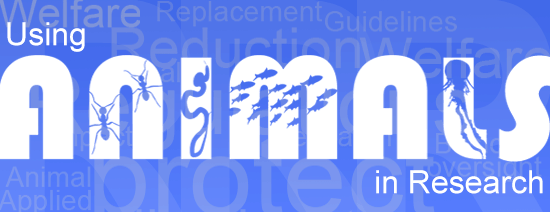The Goals of Using Animals in Research

While there are both advantages and disadvantages to using animals in research, the goal is to help scientists ask important questions and make discoveries. This can be done using different types of research.
There are many different kinds of research, and each kind is important. It would be very difficult to categorize every type of research because of the different focuses and interest. But in general, we can think of them as being in one of two categories: basic and applied.
Basic Research
Some scientists perform basic research. This means that they study different things, like plants or animals, to improve our general understanding of them. Basic research can apply either to the whole animal or a specific part, like the brain or heart. Scientists may study an animal by watching it in its natural environment or capturing it and bringing it back to the lab to study it more closely. This might include collecting samples from the animal, like blood or saliva, or simply watching how it behaves in different environments.
Applied Research
Other scientists use animals to perform applied research. This type of research applies the information that is learned through basic research to help create solutions to problems in many other different fields, like medicine, technology, and education.

These solutions are often linked to specific problems that scientists are interested in solving.
While scientists will often break research down into one of these two types, there is often overlap between the two. For example, in many cases basic research is the foundation for applied research. Scientists can use what they learn from animals and apply this knowledge in new and unique ways to solve problems and help people or other animals.
The Impact of Research on Animals
Regardless of the type of research, the effect on an animal will vary. In some cases the effect on animals in research is low. This may include instances where scientists observe the behavior of an animal in its natural environment. But it can also have greater impact on an animal. Basic physiology research as well as many types of applied research often involve taking the life of the animal in order to study it.
The impact on an animal must be reported to different organizations that oversee research before a project begins. This means that scientists must justify why the study is important and why it is necessary for the animals to be used. The oversight provided by these organizations helps ensure that scientists are being cautious in their work with regard to the use of animals.
Additional images via Wikimedia Commons. Gila monster image by Josh Olander.
Read more about: Using Animals in Research
Bibliographic details:
- Article: Goals of Animal Research
- Author(s): Dr. Biology
- Publisher: Arizona State University School of Life Sciences Ask A Biologist
- Site name: ASU - Ask A Biologist
- Date published: 4 Dec, 2016
- Date accessed:
- Link: https://askabiologist.asu.edu/animal-research-outcomes
APA Style
Dr. Biology. (Sun, 12/04/2016 - 23:33). Goals of Animal Research. ASU - Ask A Biologist. Retrieved from https://askabiologist.asu.edu/animal-research-outcomes
Chicago Manual of Style
Dr. Biology. "Goals of Animal Research". ASU - Ask A Biologist. 04 Dec 2016. https://askabiologist.asu.edu/animal-research-outcomes
Dr. Biology. "Goals of Animal Research". ASU - Ask A Biologist. 04 Dec 2016. ASU - Ask A Biologist, Web. https://askabiologist.asu.edu/animal-research-outcomes
MLA 2017 Style

Scientists study many animals, like the Gila monster shown here, for both basic and applied research purposes.
Be Part of
Ask A Biologist
By volunteering, or simply sending us feedback on the site. Scientists, teachers, writers, illustrators, and translators are all important to the program. If you are interested in helping with the website we have a Volunteers page to get the process started.

